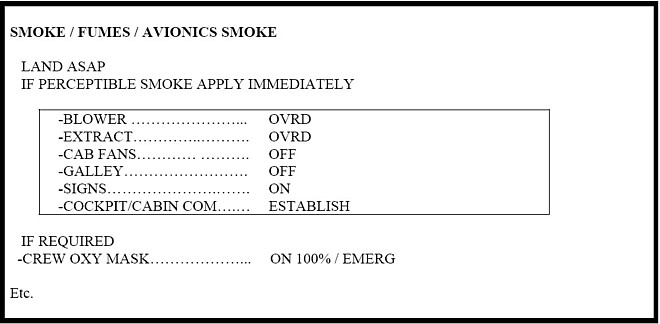
THE AIRLINE PILOTS FORUM & RESOURCE
Fumes and Contaminated Air Checklists |
| Source: Aviation Contaminated Air Reference Manual |
 |
| Checklist Ambiguity Boeing and Airbus © | 10th April 2008 |
| by Susan Michaelis | |
Along with a complete lack of education, the same arguments that were applied to the BAe 146 checklist wording regarding fumes whether visible or not, suspected or positively identified applies to other aircraft types as well. The words which should have been added to the words ‘Fire or Smoke’ in emergency checklists, on all aircraft, to deal with contaminated air events should have been, ‘Suspected Contaminated Air / Fumes.’ These words have now been introduced on some aircraft types (even if the significance has not been made clear to crews), but yet again the national regulators do not seem in a hurry to bring in change and ensure that all aircraft checklists contain these words. In the United Kingdom a review in January 2006 of emergency checklists for two different UK airlines who both operated the Boeing 747-400, both had differing emphasis. The initial parts of the checklists including the memory items are as shown in figures 1 and 2.
The Boeing 747-400 checklist for ‘Airline A’ has the sensible emphasis of, ‘SMOKE FUMES FROM AIR CONDITIONING and SUSPECTED CONTAMINATED AIR.’ In contrast as of January 2006 the incorrect older emphasis was still found on the ‘Airline B’ Boeing 747-400, of, ‘SMOKE/FUMES AIR CONDITIONING’ followed by the comment of, ‘Condition: A concentration of air conditioning smoke/fumes is identified.’ There could be and in our experience is a major difference in a pilot’s mind set between the words suspected and identified as the pilots will see the responsibility for possibly grounding an aircraft due to fumes resting with themselves. Therefore most pilots would be more willing to report fumes if they were simply following the checklist which allows them to ‘suspect’ the air was contaminated rather than having to positively ‘identify’ something they cannot see. In other words there could be a greater reluctance to report fumes when required to follow the checklists with the older emphasis on identification of fumes. Then again any checklists that still list only smoke and fire are clearly directing the pilot towards the mind set that fumes do not have to be reported, which is completely contrary to the actual regulations.
Figure 1: ‘Airline A’ Boeing 747-400 SMOKE FUMES FROM AIR CONDITIONING and SUSPECTED CONTAMINATED AIR CHECKLIST

Ironically, within ‘Airline A’, their Boeing 737-400 emergency checklists had the same emphasis as their B747-400 checklists but both ‘Airline A’ and another UK airline, ‘Thomson Fly’ still had checklists with the older emphasis on their Boeing 757s. The Boeing 757 having been plagued by contaminated air problems as can be seen in Appendix 2.
Figure 2.:’Airline B’ Boeing 747-400 SMOKE/FUMES AIR CONDITIONING Checklist

These key words of, ‘SMOKE FUMES FROM AIR CONDITIONING and SUSPECTED CONTAMINATED AIR’ are also missing from the aircraft types with the most reported incidents (based on the UK contaminated air database shown in Appendix 2 and the UK Civil Aviation Authority MOR database) such the BAe 146, Embraer Emb-145, Dash 8 Q400 and the Airbus A320. Despite the CAA FODCOMs clearly stating that putting oxygen masks on is the very first thing crews should do in the event of suspected contaminated air, the A320 checklist from ‘Airline A’ in 2005 directs crews to use oxygen, ‘if required’ and only after numerous other procedures have been completed. This is shown in Figure 3.
Figure 3: ‘Airline A’ Airbus A320 Smoke / Fumes / Avionics Smoke Checklist

All these initiatives described may seem to non aviation people as more than enough steps to get crews to do the job properly and to take contaminated air events seriously. However, without education the message and guidance is lost and hence why the problem still exists. Twenty years of seeing contaminated air as a nuisance and a problem that has proven very difficult and costly to address is not easy to overcome. Crews are not told about those who lose their health due to contaminated air exposure either. If crews had greater awareness of this it might focus their minds on being more cautious and acting properly. The failure of the regulator and airlines to undertake the education process saw many unions take on the educational role which shows the scale of the problem.
The pilot unions that made some effort to educate its members are the Australian Federation of Air Pilots (AFAP) in Australia who led the way, the Independent Pilots Association (IPA) in the UK and the other UK pilot union BALPA. Union education has involved sending the AOPIS DVD, entitled – ‘Aircraft Air Contamination, An ongoing Health & Safety Issue’ to members, as well as leaflets, newsletters and internet based information. Union education is very limited when faced with an airline industry pretty much stating an opposite view, especially on health related matters. Had the regulators, airlines and unions tackled this together, then the issue may well be resolved today and passengers and crews would not continue to be exposed. Instead, flight safety is compromised daily by crews not acting properly when contaminated air events occur.
Flight Safety Aspects of Contaminated Air
Reporting Contaminated Air Events with Samples of Known Events
FODCOM (Flight Operations Department Communication) number 17/2000
FODCOM (Flight Operations Department Communication) number 14/2001 and 21/2002
You are reading >> Checklist Ambiguity Boeing and Airbus
Aviation Regulators Misinterpret Main Ventilation Airworthiness / Safety Standard
